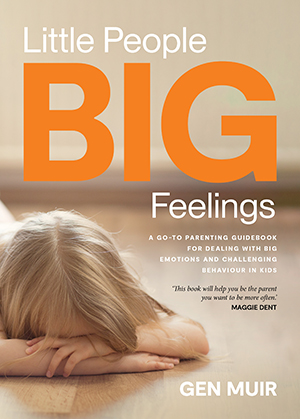
By Gen Muir
What if the secret to helping our children with meltdowns was as simple as leaning in, not out? What if mostly what our kids need is us for to surrender and accept the emotion?
When our child is having a meltdown, every instinct in our body wants to stop the noise, help our child, or protect ourselves. We can know the parent we want to be in these moments in theory, and yet in the moment we can find our palms sweating, our shoulders tensed, our jaw clenched, our heart rate elevating and a strong feeling of ‘No, no, no, not THIS again!’. Many parents describe it as ‘walking on eggshells’; they know a meltdown is coming and they’ll do anything to prevent it.
If our desire is to stop the meltdown, we may attempt to distract our child, solve the problem or even ignore or punish our child, in the hope it will help. In all these instances we are dealing with the behaviour only (i.e. stopping the crying/yelling/whingeing/ stomping) and we are not dealing with the underlying emotion, which is the cause of the meltdown.
Meltdowns are like smoke alarms
One of the ways to think about all behaviour, including meltdowns, is to picture that your child having a meltdown is the smoke alarm going off on the roof. It’s loud, annoying, inconvenient and it sometimes gives us a fright. Trying to stop a meltdown in a child by focusing only on stopping the behaviour is like trying to stop the smoke alarm going off by pointing your hose at the alarm. We are missing the reason the alarm went off; we need to find the fire. The behaviour is the smoke alarm going off, but the fire is the underlying emotions; the reason why your child is melting down.
While a child may be crying because you peeled their banana wrongly, if you only deal with the crying (the behaviour) you are missing the point. We need to help our child to start to understand the reason they are crying, because there is always an underlying emotion, even if we can’t name it.
We’ve all felt the public shame of our child not coping in a social situation. We think, ‘My child will never learn to socialise with others! This is so embarrassing; What will the neighbours think?’ I can’t imagine there is a parent on earth who doesn’t cringe at the thought of a public meltdown because we’ve all felt that complex mix of emotions that happen when our child loses it in front of others.
And it’s hard to meet our child’s emotions when we are being blinded by our own. For this reason, we need to learn how to lean in to emotions and find the fire as often as possible at home, so that when a meltdown happens in front of others, we’ve had some practice. This can help our reactivity.
Five steps to finding the fire
- First, we pause
We need to first be aware that it’s likely that we are in a state of shame, or at least embarrassed. It never, ever feels good when our child loses it in public, or in front of others. Offer yourself compassion because these moments in parenting are HARD. By acknowledging that we feel embarrassed, we are less likely to yell at or shame our child from that place where we are unaware what’s driving our responses. Try taking a deep breath and placing your hand on your heart. Ground yourself, ready to be what your child needs and prevent a reaction that comes from shame. - Focus only on what THIS moment requires
Tune in to your child’s emotional state and recognise that no child wants to yell at their friends and make a social mistake. This is compassion. Refrain from scrolling forward in your mind and picturing that they might ‘never learn to be resilient’ and if they ‘carry on like this they will never make friends’ etc. It won’t help you at this moment, and can be simply fear talking.
Try a mantra: ‘This is a good kid having a hard time.’ - Contain
This is where we take charge if needed and this may be by containing the situation. You may need to get close, take charge and step in with the intention of helping your child. Remember no kid wants to get it wrong so you need to help them out when they need it.
A father could try saying: ‘I am not going to let you yell at your friends. Let’s get inside so that we can calm down together. Girls, we will be back in a second.’ - Name it to tame it
Finding the fire is all about looking beyond the behaviour of yelling to the feelings underneath. When we talk about what might be happening for our child, we build their ability to regulate better next time.
Once in the room the father could say: ‘Wow, things got really out of hand there. You have worked on building this activity all day. You were so excited and when the girls didn’t want to play your idea you got disappointed and maybe even a little embarrassed they didn’t like your idea? I get it. I would have been absolutely gutted if I were you too.’ This works to uncover the underlying emotion and source of ‘the fire’. - Then we coach
Maybe you and your child hug, maybe you sit in silence for a second, but once you notice your child is in a better state to hear, you might say: ‘What do you think we should do now?’
The father might say, ‘I wonder if the girls also had their own idea in mind? Maybe we could go and suggest a compromise, that we play their idea for 10 minutes and then we do the obstacle course?
What do you think?’
Many people reading this may be immediately recalling a moment that didn’t go like the above. If you are feeling like you recently got it all wrong, please remember we are trying to get this stuff right around 30–40 per cent of the time. Be kind to yourself – you are doing much better than you think.

This is an edited extract from Little People, Big Feelings by Gen Muir
– out now, Macmillan Australia, RRP $36.99.
